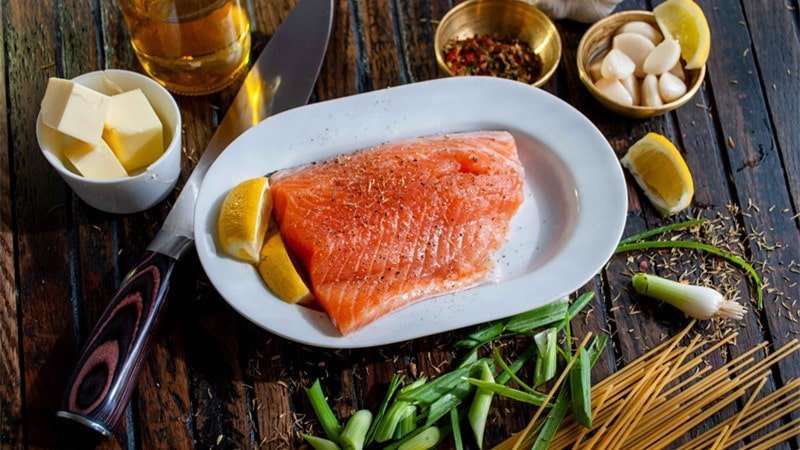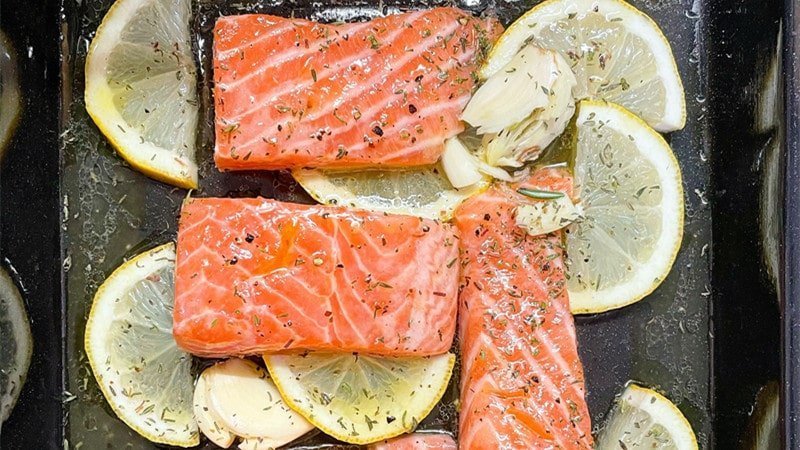If you had to rank the tastiest fish you’ve ever tried, salmon will likely top your list. It has a rich, yet refreshing taste that goes well with roast potatoes, salads, or as a part of a sushi roll. But every salmon lover has found themselves wondering whether a forgotten salmon package from the fridge is still good to eat.
Worry not! This complete guide on salmon will teach you everything you need to know about this fish. From how to tell if salmon has gone bad, how long it will last, and how to properly preserve it.
How to Tell If Salmon has Gone Bad

Cooking can be a tricky art, especially if you’re new to it. You have to keep measurements in mind, add plenty of spices, and cook things at the right temperature. However, few online recipes flag that you should also make sure your food is still good to eat.
You may think this is obvious, but you’d be surprised. It’s actually very easy to eat a rotten piece of food, especially if you’re not vigilant about how you store it or when you use it. This is especially true for frozen fish like salmon.
So, if you want to know how to tell if salmon has gone bad, keep an eye out for three major red flags.
1. It Has a Strong, Rancid Smell Similar to Ammonia
The first and most obvious sign that food has gone bad is the smell. Rotten food has a very specific, musty, or moldy smell that instantly puts you off eating it. But since fish already has a pretty powerful natural odor, figuring out if it smells bad gets tricky.
To tell the difference, pay attention to the smell’s intensity. When you pull salmon out of the fridge or freezer, it should have a sharp, but mild fishy smell. If the fish smells too sour, or if it smells like ammonia, then according to the Food and Drug Administration, your salmon has gone bad.
If you still can’t tell whether your raw fillet has gone bad, drop it in the pan and fry it for a few minutes. Rancid salmon will start smelling even worse when it’s heated, so the sour ammonia stench will be amplified. This will make it easy to tell for certain if your fish has expired.
However, if you’re still not certain about the smell, go with your gut. Our sense of smell may not be as powerful as that of other animals, but we still have a pretty impressive nozzle. We’ve evolved to smell specifically to be able to consume things safely and avoid ingesting rotten or poisoned food. So if your fillet smells even a bit off, don’t risk it.
As wasteful as it seems, go with your instincts and toss the fish. Getting another fillet is easy. But recovering from food poisoning is not.
2. Pay Attention to The Eyes, Scales, and Gills
If you’ve splurged on a whole salmon, instead of a fillet, then telling if it’s gone bad is even easier. First, pay attention to its eyes.
Fresh fish will always have clear, glossy eyes. If the eyes have a greyish color, or if they appear murky or cloudy, then that’s a sign the fish has been sitting out too long, and that it’s starting to rot. It can also be a sign that a salmon had some kind of disease before it was caught. Either way, the fish should go to the trash can.
Next, there are the scales. Good salmon will have metallic grey scales that shimmer when you expose them to light. However, if the scales appear dull and slimy, then the fish has started rotting.
This doesn’t have to apply to the entire salmon. Sometimes, dull scales appear in patches. Therefore, before frying, be sure to inspect the whole salmon for any discoloration.
Lastly, there are the gills. Quality, fresh fish will have clean and bright red scales. What’s more, while the gills will be slippery to the touch, they won’t be overly greasy. However, if the gills start browning, and oozing a thin film of slime, then you can put your salmon diner off for another night.
3. Its Flesh Will Appear Discolored
On the subject of color, let’s discuss another sign that your salmon has gone bad. Salmon is known for its distinctive dark pink color. The darker, the better.
However, did you know that only wild-caught salmon have pink-colored flesh? Wild salmon survive on a diet rich in astaxanthin, a reddish-orange compound found in krill and shrimp. It’s this compound that gives their meat that trademark color.
But since wild-caught salmon is extremely expensive, over 70% of the salmon you find on the market is farm-raised. And farm-raised salmon eat whatever farmers throw into their pen. This can include corn, soybeans, or kibble made from leftover anchovies and herring.
As a result, their flesh is naturally grey. However, to appeal to the market, farmers will add astaxanthin to their salmons’ diets to color their flesh pink. In fact, they can actually control the intensity of the color by adjusting the amount of astaxanthin in the kibble. Since dark pink salmon sells the best, farmers will use astaxanthin in high doses.
So if you’ve heard that quality salmon will have a dark pink color, you’ve been misled. The color intensity only matters if you’re splurging on wild-caught salmon. But don’t think that means you should completely disregard color.
Instead of looking at the intensity of the pink hue, pay attention to the brightness. Good salmon, both wild and farmed will have brightly colored flesh that feels firm to the touch. Soft, grainy, or flaky flesh that falls apart when you touch it means the salmon has definitely gone rancid.
What Happens If You Eat Bad Salmon

Despite our best efforts to eat good food, accidents happen. Whether you went to a restaurant and had some questionable sushi, or absentmindedly cooked a salmon fillet that was past its expiration date, the result is the same — you ate bad food.
In that case, make sure to call in sick to work, because you’re in for a nasty bout of food poisoning. Food poisoning happens when you ingest the harmful bacteria that breed on spoiled food and release toxins that cause it to rot.
The symptoms may set in a few hours, or maybe a couple of days after you’ve eaten the rancid food. The intensity will also depend on the amount of bad food you’ve consumed. When it comes to food poisoning you get from fish specifically, we distinguish between several types. Two types of bacteria are most commonly associated with salmon.
1. Salmonella
Salmonella go hand in hand with raw chicken and spoiled eggs. But poultry isn’t the only way you can contract this dangerous bacteria. The pathogen lives in the intestinal tract of many different farm animals, and is spread through infected feces.
Since factory farms often don’t practice safe waste disposal, it’s common for them to dump infected feces in saltwater. There, it can infect salmon, and in turn get into your system, especially if you eat the fish raw.
The most common signs of salmonella poisoning include nausea, vomiting, and diarrhea. In more extreme cases, sufferers will also experience a fever, abdominal cramps, and joint pain. These symptoms will often set 12-72 hours after you’ve ingested rancid salmon.
On average, salmonella will go away on its own after 4-7 days. However, it can take months for your gut to go back to normal. What’s more, if your symptoms last for longer than 7 days, or you experience bloody diarrhea, and a fever of 101.5 F then you should definitely visit your doctor, ASAP.
2. Vibrio Vulnificus
Though it’s less known than salmonella, vibrio is an even more dangerous breed of bacteria. It‘s most commonly found in saltwater during the warm summer months. Thus, it’s a pathogen exclusively associated with eating raw or undercooked seafood like oysters, and shellfish.
However, you can also get it from salmon, if cross-contamination occurs either during storage or preparation. Once ingested, in most cases vibrio will cause food poisoning similar to salmonella.
But what makes it more dangerous is that it can also cause severe skin infections. In mild cases, this can look like a simple allergic reaction — rashes, skin irritation, itching, and swelling. However, this skin irritation can easily turn into necrotizing fasciitis. This flesh-eating bacteria spreads quickly and causes your flesh to rot.
It’s an incredibly dangerous condition that requires powerful antibiotics, and in some cases, amputation to stop. If left untreated, it may cause blood poisoning and multiple organ failure.
Therefore if you’re experiencing a skin rash and itching after eating a salmon nigiri, go see your doctor immediately.
How Long Does Salmon Stay Good in the Fridge?

The risks of eating bad salmon are enough to put you off this fish for life. However, you shouldn’t let the downsides ruin your favorite dish. It’s very unlikely that you’re going to eat bad salmon, especially if it’s been stored correctly.
After it is caught, manufacturers flash freeze salmon at its peak freshness point. In this flash-frozen state, the salmon can last for 3-4 months, especially if you immediately place it in your freezer after buying. If you keep the fish in below 0 temperatures, you can even make it safe indefinitely.
However, if you decide to place the salmon in your fridge, then your expiration date shortens drastically. Though the cold temperature will slow the dethawing process, it will defrost fairly quickly. Salmon fillet will typically last anywhere between 1-2 days in the fridge. You can extend this time to 2-3 days if you leave the package unopened.
However, if the flash-frozen salmon had already started dethawing before you got a chance to place it in the fridge, then your best bet is to use it immediately. Cooked salmon can easily last 3-4 days in the fridge, and up to 4 months in the freezer. Therefore, even if you aren’t hungry for salmon at the moment, you can always save the cooked fish for another day.
How to Store Salmon

After covering how to tell if salmon has gone bad and how long it will last in the fridge, there is one last thing to cover — how to store salmon. As mentioned, the moment its caught, salmon gets flash-frozen to preserve its freshness.
In order to make sure it stays good, it’s important that you immediately store the salmon in a cold place. You can keep it in the fridge if you plan on using it the following day. However, if you want to save the salmon for special occasions, the only way to do this is to store it in the freezer.
When storing, be sure to keep the package unopened. A lot of frozen fish comes in vacuum-sealed packages. Vacuum seals remove all the oxygen from the package, thus stopping oxidation. This in turn prevents toxic bacteria from growing, since they require oxygen to breed.
To further protect the package, you can also wrap it with an airtight heavy-duty aluminum foil, plastic wrap, or freezer paper, before placing it in a heavy-duty freeze. This will keep your salmon fresh for months, even years, while also stopping freezer burn.




